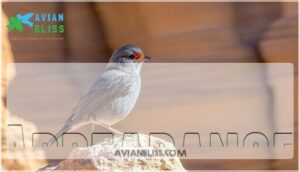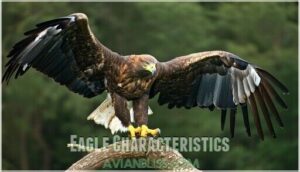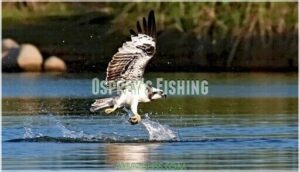This site is supported by our readers. We may earn a commission, at no cost to you, if you purchase through links.

Eagles weigh up to 14 pounds with 82-inch wingspans, while ospreys max out at 5 pounds with 70-inch wings.
Eagles often steal fish from ospreys rather than hunt themselves – it’s basically aerial piracy.
Ospreys counter with incredible fishing precision, catching fish 99% of the time they dive.
Their reversible outer toes and specialized talons grip slippery prey better than any eagle.
While eagles win direct confrontations, ospreys outmaneuver them through speed and determination.
The real battle reveals surprising strategies each species uses to survive.
Table Of Contents
- Key Takeaways
- Physical Differences
- Osprey Characteristics
- Eagle Characteristics
- Predatory Behavior
- Aggressive Interactions
- Food Acquisition
- Behavioral Adaptations
- Ecological Coexistence
- Frequently Asked Questions (FAQs)
- Do osprey and bald eagles fight?
- Can an osprey beat an eagle?
- Is an osprey a type of eagle?
- How do you tell an osprey from an eagle?
- Are osprey and sea eagles the same?
- What are mating rituals of ospreys and eagles?
- Do ospreys and eagles build their nests similarly?
- Can ospreys and eagles interbreed?
- How does climate change impact ospreys and eagles?
- What conservation efforts exist for osprey and eagle?
- Conclusion
Key Takeaways
- You’ll see eagles dominate through size and aggression – they’re nearly three times heavier than ospreys and use their 6.5-foot wingspan to steal fish through aerial piracy rather than hunting themselves.
- You’ll witness ospreys excel as specialized fishing machines – they achieve 99% success rates when diving and use reversible outer toes with specialized talons to grip slippery fish better than any eagle.
- You’ll notice eagles win direct confrontations but ospreys counter with speed and persistence – while eagles use brute force and intimidation, ospreys respond with erratic flight patterns and quickly resume fishing after losing catches.
- You’ll discover both species coexist through different hunting strategies – eagles diversify their diet and scavenge opportunistically, while ospreys focus exclusively on live fish, creating ecological balance that allows both to thrive.
Physical Differences
When you spot these magnificent birds soaring overhead, you’ll notice some striking physical differences that make identification easier than you’d think.
Eagles are substantially larger and more robust, while ospreys have a sleeker build with distinctive markings that set them apart from their powerful cousins, making identification easier.
Body Shape
At first glance, you’ll spot dramatic differences in osprey and eagle body shapes.
Ospreys feature streamlined, elongated torsos built for precision diving, while eagles showcase robust, muscular frames designed for raw power.
Key Body Shape Differences:
- Wing Structure – Ospreys display narrow, bent wings with prominent M-shapes; eagles have broad, straight wings
- Head Form – Ospreys possess sleeker heads with angular faces; eagles show blockier, more powerful heads
- Beak Shape – Ospreys have sharply hooked beaks; eagles feature deeper, flesh-tearing beaks
- Tail Length – Ospreys sport medium-length, barred tails; eagles have shorter, fanned tails
- Feather Patterns – Ospreys show distinct dark eye stripes; eagles display uniform coloring
These body shape adaptations directly influence osprey identification and eagle identification in the field.
Size
When comparing size, eagles dominate the wingspan comparison and weight difference. Eagles outweigh ospreys by nearly three times, creating a dramatic scale variance in body proportions.
The height contrast reveals the true dominance, with specific measurements for each bird type:
- Bald eagles: 31 inches long, 6.5-foot eagle wingspan, 9.5 pounds
- Golden eagles: 30 inches long, 6.5-foot wingspan, 10 pounds
- Ospreys: 23 inches long, 5.25-foot osprey wingspan, 3.5 pounds
This eagle size versus osprey size difference reflects their hunting roles—eagles tackle larger prey while ospreys specialize in fish.
Flight Speed
Velocity transforms these aerial predators into formidable hunters. When comparing osprey vs eagle flight speed, eagles dominate the skies with superior aerodynamic traits and powerful wing beats.
| Bird Type | Cruising Speed | Dive Speed | Maximum Speed |
|---|---|---|---|
| Osprey | 30-40 mph | 50 mph | 80 mph |
| Bald Eagle | 35 mph | 100 mph | 100 mph |
| Golden Eagle | 60 mph | 200 mph | 200 mph |
Eagles excel in airborne chases with their broader osprey wingspan versus eagle wingspan advantage. Flight patterns reveal ospreys hover before striking, while eagles use explosive bursts for territorial dominance, showcasing their superior aerodynamic traits.
Lifespan
You’ll discover that eagle lifespan substantially exceeds osprey lifespan in the wild.
Eagles soar through 20-30 years compared to ospreys’ average lifespan of 7-10 years.
This longevity gap affects breeding cycles and territorial dominance.
Mortality rates vary based on habitat threats, with survival rates impacting each species’ ability to maintain established territories.
The aging process favors eagles’ extended reproductive years over ospreys’ shorter lifespans.
Diet
Dietary differences between ospreys and eagles reveal fascinating contrasts in prey capture methods. Ospreys are fish consumption specialists, diving feet-first with reversible outer toes for secure grip.
Eagles showcase diverse hunting tactics, targeting multiple food sources beyond fish. Here are key dietary needs distinctions:
- Osprey diet: 99% fish including trout and mullet
- Eagle diet: Fish, mammals, birds, carrion, eggs
- Daily intake: Ospreys need 300-500g fish; eagles require 400-600g varied prey
- Hunting success: Osprey fishing achieves 50-70% success rates
- Adaptation: Eagles scavenge when fish are scarce
Osprey Characteristics
When you’re trying to identify an osprey, you’ll notice their distinct slender build and unique fishing adaptations that set them apart from eagles.
These specialized raptors showcase remarkable features like their reversible outer toes and waterproof feathers that make them perfectly designed for their aquatic hunting lifestyle.
Height
When you compare standing height between these raptors, the size difference becomes clear.
Ospreys stand 21-26 inches tall, while bald eagles tower at 27-35 inches.
This tallness comparison reveals fundamental differences in body proportions that shape their hunting strategies.
- Osprey height: Compact and streamlined for precise fishing dives
- Eagle height: Imposing stature built for territorial dominance
The osprey vs bald eagle size difference isn’t just about measurements—it’s about specialized design.
Each bird’s height reflects its ecological role perfectly.
Understanding osprey height comparison charts is essential for appreciating these differences.
Wingspan
When comparing osprey vs eagle wingspan measurements, you’ll notice striking differences that define their aerial dominance. Ospreys display impressive wing length spanning 59-70 inches, while eagles command respect with massive feather spans reaching 80-88 inches.
| Bird Type | Wing Length | Flight Reach | Aerodynamic Advantage |
|---|---|---|---|
| Osprey Wings | 59-70 inches | Precise maneuvers | Quick directional changes |
| Eagle Wingspan | 80-88 inches | Extended soaring | Maximum aerodynamic lift |
| Comparison | Eagles 20% larger | Eagles dominate | Different specializations |
These wing tips create distinct advantages—ospreys excel in tight fishing maneuvers while eagles master effortless soaring through superior aerodynamic lift capabilities, showcasing their unique flight reach.
Flight Behavior
You’ll spot ospreys by their distinctive flight patterns and soaring techniques.
These birds showcase remarkable flight characteristics with their slow, steady wing beats creating a methodical rhythm above water.
When hunting, they hover like helicopters before executing precision plunge-diving maneuvers.
Their dive speed reaches impressive velocities, while specialized feathers act as natural air brakes during underwater pursuits.
This aerial mastery makes ospreys unmatched fishing specialists.
Appearance
Beyond flight patterns, an osprey’s appearance commands attention through distinctive physical characteristics.
You’ll spot its white head plumage marked by bold black eye stripes that create a masked bandit look.
The feather color contrasts sharply—white underparts against dark brown wings and back.
Its beak shape is smaller and less hooked than an eagle’s massive curve.
These plumage differences make osprey eagle comparison straightforward in the field, based on characteristics such as:
- White head with striking black eye stripes
- Contrasting feather patterns of white and brown
- Smaller, less curved beak shape
- Dark brown tail feathers with narrow bands, which are key to identifying an osprey’s unique features and distinctive physical characteristics.
Resilience
Ospreys showcase remarkable environmental resilience that eagles can’t match. Their adaptation strategies include adjusting fishing depths based on water clarity and weather conditions.
When facing habitat loss, ospreys demonstrate exceptional nesting resilience by building platforms on man-made structures. Their climate adaptation skills help them survive harsh winters through strategic migration patterns.
| Resilience Factor | Osprey Response | Eagle Response |
|---|---|---|
| Habitat Loss | Adapts to artificial nesting sites | Requires large territories |
| Food Scarcity | Varies fishing techniques | Competes aggressively |
| Weather Changes | Adjusts hunting depths | Less flexible approach |
| Human Disturbance | Tolerates nearby activity | Abandons disturbed areas |
| Nesting Threats | Rebuilds quickly | Takes longer recovery |
Ospreys’ ability to adapt to different conditions, such as varied fishing techniques and strategic migration, makes them more resilient than eagles in certain aspects. Overall, ospreys have developed unique strategies to cope with various challenges, showcasing their remarkable adaptability.
Eagle Characteristics
You’ll notice eagles are built for power and dominance, with broader wings, larger beaks, and more aggressive hunting styles than their osprey counterparts.
These formidable birds of prey use their size advantage and territorial nature to establish themselves as apex predators in their environments.
Aggression
Eagles dominate through territorial defense and aggressive displays that showcase raw power.
When they encounter ospreys, eagles launch attack strategies involving swift pursuits and intimidating postures.
This predatory behavior isn’t random violence—it’s calculated competitive behavior designed to steal fish and maintain dominance.
Eagles understand the predator prey dynamics perfectly, using their size advantage to force smaller birds into submission through relentless aggression.
Osprey’s Flight
Watching an osprey’s precise Flight Patterns reveals nature’s engineering mastery.
You’ll notice three key flight characteristics:
- Wing Beats: Steady, powerful strokes maintain controlled hovering over water
- Air Speed: Reaches 30-40 mph during hunting approaches
- Dive Techniques: Sharp, feet-first plunges from Soaring Heights up to 130 feet
Their wingspan spans 5-6 feet, creating perfect lift for this bird species’ fishing expertise.
Eagle’s Flight
Something about an eagle’s soaring techniques will leave you speechless.
These masters reach diving speeds of 100 mph while riding thermal currents effortlessly. Their broad wings enable smooth glides that conserve energy across vast distances.
Flight adaptations make them aerial champions – watch them twist and turn with precision during hunting flight. Eagles soar with unmatched control, whether pursuing prey or following migration patterns.
Their flight mastery shows pure domination of the skies.
Predatory Behavior
You’ll notice distinct differences when observing how these powerful raptors approach hunting and feeding.
While ospreys focus exclusively on catching live fish through spectacular diving techniques, eagles employ more varied and opportunistic predatory strategies.
These strategies include scavenging, stealing prey from other birds, and hunting diverse animals both in water and on land, showcasing their adaptability and versatility as powerful raptors.
Eagle’s Predation
Power defines the eagle’s world through calculated aggression and tactical brilliance.
These apex predators master four distinct predation tactics:
- Ambush hunting – striking from concealed perches with 400 psi talon force
- Kleptoparasitism – stealing catches from smaller raptors like ospreys
- Cooperative strikes – coordinating attacks to improve success rates
- Opportunistic scavenging – adapting prey selection based on seasonal availability
Their killer instinct drives hunting strategies across diverse habitats, targeting over 100 species with visual acuity five times sharper than humans.
Eagles, like other bird predators, play a vital role in maintaining the balance of their ecosystems.
Osprey’s Hunting
Masterful predators, ospreys combine precision with specialized diving techniques that make them unmatched fish eating birds.
These plungediving experts hover 30-100 feet above water before executing perfect plunge diving strikes with sharp talons. Their hunting strategies showcase remarkable prey selection, targeting fish 15-35 centimeters long with up to 99% success rates in ideal osprey habitat.
Ospreys rely on proper diving gear scuba diving equipment to enhance their underwater capabilities.
Osprey hunting features include:
- Reversible outer toes for secure fish capture
- Waterproof plumage preventing water intake during dives
- Barbed footpads gripping slippery prey with 400 psi pressure
- Instant nostril closure underwater to prevent drowning
Aggressive Interactions
When you’re watching these aerial predators in action, you’ll notice that eagles often chase ospreys to steal their freshly caught fish rather than hunt for themselves.
You’ll see ospreys respond by flying erratically, dropping their catch, or seeking refuge near water where their superior diving skills give them an advantage, and this behavior is a key example of how ospreys use their environment to counter aerial predators.
Eagle’s Pursuit
When an eagle spots an osprey clutching fresh prey, the aerial drama unfolds with calculated precision.
The eagle’s hunting technique involves swift descent and aggressive positioning to intimidate its target.
Using superior size and wingspan advantage, it employs pursuit strategies that force the osprey into defensive flight patterns.
These aerial chases showcase the eagle’s mastery of hunting tactics, where persistence often trumps speed.
The eagle vs osprey dynamic reveals nature’s power hierarchy in action.
This behavior is a classic example of bird aggression triggers that can lead to intense competitions for resources.
Osprey’s Response
When facing an eagle’s aggressive pursuit, ospreys don’t simply surrender their catch without a fight.
Ospreys fight back with aerial acrobatics that would make fighter pilots jealous.
These skilled fish-hunters deploy sophisticated Osprey Defense strategies that showcase their aerial mastery:
- Flight Patterns shift to erratic, unpredictable movements that confuse pursuing eagles
- Predator Avoidance tactics include sharp climbs and sudden directional changes mid-flight
- Hunting Tactics adapt quickly—they’ll drop fish strategically to escape, then resume fishing elsewhere
This osprey vs eagle dynamic demonstrates nature’s complex battle for survival, where ospreys and eagles maintain their ecological similarities through calculated responses.
Food Acquisition
When you’re watching these magnificent birds hunt, you’ll notice they’ve mastered completely different approaches to securing their next meal.
Ospreys are fishing specialists that plunge feet-first into water with pinpoint accuracy, while eagles take a more opportunistic route, snatching fish from the surface, stealing catches from other birds, or scavenging whatever’s available.
Osprey’s Fishing
Ospreys possess unmatched fishing techniques that make them nature’s premier fish hunters.
These skilled raptors hover over water at precise angles before executing lightning-fast plunge-dives from forty meters high. Their dive speed reaches eighty mph, while specialized reversible outer toe anatomy guarantees prey capture success rates of fifty to eighty percent.
Operating in diverse fishing habitat from lakes to coastlines, Pandion haliaetus maintains an exclusive fish diet through calculated strikes averaging under five seconds from spot to catch success.
The effectiveness of their fishing methods relies on proper fishing gear selection tools to maximize their hunting efficiency.
Eagle’s Hunting
When eagles lock onto their target, they deploy devastating hunting strategies that showcase their aerial supremacy.
Their talon strength and precision dive speed make them formidable raptors among birds of prey.
Here’s how eagles dominate through strategic prey selection:
- Stoop dives at 150+ mph deliver crushing force
- Perch hunting from elevated positions maximizes surprise attacks
- Territorial patrols exhaust waterfowl through repeated flyovers
- Cooperative tactics between mated pairs coordinate strikes
Golden eagles prefer mammals while bald eagles target fish and waterfowl.
Their sharp eyesight spots prey from extreme distances, making eagle hunting incredibly efficient compared to golden eagle vs osprey scenarios.
Eagles play a vital role in maintaining ecosystem balance through their eagle hunting prey techniques.
Behavioral Adaptations
You’ll notice striking differences when you observe how these birds adapt their behavior to survive and thrive in their environments.
Ospreys show remarkable determination in their fishing pursuits, while eagles display aggressive tactics that help them dominate their territories and secure food sources.
Osprey’s Determination
Despite relentless harassment from eagles, you’ll witness remarkable resilience in osprey behavior.
These skilled raptors refuse to surrender their fishing strategies, quickly returning to proven diving techniques after losing a catch.
Their survival tactics include immediate readjustment—if an eagle steals their fish, they’ll hunt again within minutes.
This osprey vs eagle dynamic showcases incredible hunting skills and nesting habits that prioritize persistence over confrontation.
Golden eagle vs osprey encounters highlight how different raptors comparison strategies work.
Bird identification guide experts note ospreys’ unwavering focus on their eagle habitat territories, demonstrating that determination often trumps size in aerial conflicts.
Ospreys’ ability to thrive in various environments is linked to their unique fishing adaptations, which enables them to adapt and survive, showcasing their adaptability and strong survival tactics.
Eagle’s Aggression
Aggressive Behavior defines eagles as apex predators who won’t back down from confrontation.
Eagles command respect through sheer force—when they want something, they take it.
These raptors execute bold Eagle Attacks against competitors, using their massive talons as weapons of intimidation.
You’ll witness their Territorial Defense when they chase ospreys from prime fishing spots, employing swift Predator Tactics that showcase raw strength.
Their Threat Response involves aggressive posturing and direct confrontation rather than retreat.
Eagles dominate their habitat through calculated aggression.
- Eagles boldly challenge other predators.
- Their strong talons grasp tightly.
- Quick, aggressive dives intimidate rivals.
- Keen eyesight spots targets far below.
- Power play in action: Eagles steal fish from ospreys mid-flight, demonstrating that in the wild, the biggest bully often wins the meal.
Ecological Coexistence
You’ll find that ospreys and eagles share the same waterways without constant conflict, creating a fascinating example of how different hunting specialists can coexist.
While eagles may occasionally steal fish from ospreys, both species have carved out their own ecological niches that allow them to thrive alongside each other in aquatic environments.
Balance in Nature
Nature’s checks and balances create ecosystem harmony where you’ll find both osprey and eagle populations thriving.
These predator-prey relationships demonstrate natural regulation at work.
Species coexistence occurs through resource partitioning – ospreys specialize in fish while eagles diversify their hunting.
This environmental balance supports biodiversity conservation, ensuring neither species dominates completely while maintaining ecological balance across shared habitats.
Coexistence of Predators and Prey
Successful wildlife conservation depends on understanding how species interaction shapes ecosystem balance.
You’ll witness remarkable habitat sharing between these apex predators, where territorial competition drives evolutionary adaptations. Both osprey and eagle populations have learned to coexist through specialized hunting strategies.
- Predator prey dynamics: Ospreys target live fish exclusively while eagles scavenge opportunistically
- Spatial partitioning: Eagles hunt nearshore; ospreys venture into deeper waters
- Temporal separation: Different peak hunting times reduce direct competition
- Nesting strategies: Both species use tall structures but maintain territorial boundaries
- Resource abundance: Healthy fish populations support both predators simultaneously
This delicate balance guarantees neither species dominates completely, maintaining biodiversity.
Frequently Asked Questions (FAQs)
Do osprey and bald eagles fight?
You’ll witness aerial combat when these powerful birds clash over territory.
Bald eagles frequently raid osprey nests, but ospreys defend themselves using speed and agility to outmaneuver their larger opponents effectively.
Can an osprey beat an eagle?
Like David facing Goliath, you’re wondering if size determines the victor.
An osprey typically can’t beat an eagle in direct combat due to significant size and strength disadvantages, though ospreys may successfully defend nests through agility and determination.
Is an osprey a type of eagle?
No, you shouldn’t consider an osprey a type of eagle.
These birds belong to completely different families – ospreys form their own family while eagles belong to another distinct group with different hunting strategies and physical features.
How do you tell an osprey from an eagle?
Think of spotting differences between twins — you’ll notice key features that set ospreys and eagles apart.
Check the head: ospreys have dark eye stripes, eagles don’t.
Look at wing shape: ospreys’ are narrower and more angled.
Are osprey and sea eagles the same?
No, ospreys and sea eagles aren’t the same species.
You’ll find ospreys are fish specialists with unique diving abilities, while sea eagles are larger raptors that hunt diverse prey including fish, birds, and mammals near coastal areas, making them distinct in terms of diving abilities and prey preference.
What are mating rituals of ospreys and eagles?
Ever wonder how these raptors woo their mates?
You’ll witness spectacular aerial courtship displays where both species perform dramatic sky dances, with ospreys carrying fish gifts and eagles executing breathtaking dives to impress potential partners.
Do ospreys and eagles build their nests similarly?
Nest-building techniques differ substantially between these raptors. You’ll find ospreys constructing massive stick platforms near water, while eagles prefer towering tree locations with sturdy branch foundations for their enormous structures.
Can ospreys and eagles interbreed?
No, ospreys and eagles can’t interbreed.
They belong to different bird families with distinct genetic makeups that prevent successful reproduction.
You’d need closely related species within the same genus for crossbreeding to occur naturally, which involves successful reproduction.
How does climate change impact ospreys and eagles?
Climate change substantially affects both species by shifting their prey availability and migration patterns.
Ospreys are projected to lose 79 percent of current summer range by 2080, while changing temperatures force both birds to adapt their hunting grounds and timing, which is a result of climate change.
What conservation efforts exist for osprey and eagle?
You’ll seize control by targeting these proven strategies for species recovery.
DDT pesticide bans and habitat protection programs have dramatically rescued both species from near-extinction.
Federal protection laws, nest monitoring, and breeding site management now keep these raptors thriving through targeted intervention.
Conclusion
Powerful predators and precision performers create enchanting contrasts in nature’s arena.
You’ve witnessed how the osprey vs eagle matchup reveals fascinating adaptations.
Eagles dominate through brute force and opportunistic tactics, stealing catches from smaller competitors.
Ospreys counter with unmatched fishing expertise and remarkable persistence.
Neither species truly "wins" this rivalry – instead, they’ve evolved complementary strategies that minimize direct competition.
Eagles rule through intimidation while ospreys excel through specialization.
This dynamic balance guarantees both magnificent raptors thrive in shared ecosystems across North America.















